Related Research Articles

The Ashmolean Museum of Art and Archaeology on Beaumont Street, Oxford, England, is Britain's first public museum. Its first building was erected in 1678–1683 to house the cabinet of curiosities that Elias Ashmole gave to the University of Oxford in 1677. It is also the world's second university museum, after the establishment of the Kunstmuseum Basel in 1661 by the University of Basel.

Mughal painting is a style of painting on paper confined to miniatures either as book illustrations or as single works to be kept in albums (muraqqa), from the territory of the Mughal Empire in South Asia. It emerged from Persian miniature painting and developed in the court of the Mughal Empire of the 16th to 18th centuries. Battles, legendary stories, hunting scenes, wildlife, royal life, mythology, as well as other subjects have all been frequently depicted in paintings.
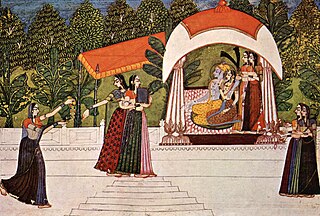
Rajput painting, also called Rajasthan painting, evolved and flourished in the royal courts of Rajputana in northern India, mainly during the 17th century. Artists trained in the tradition of the Mughal miniature were dispersed from the imperial Mughal court and developed styles also drawing from local traditions of painting, especially those illustrating the Hindu religious epics, the Mahabharata and Ramayana.
Dame Jessica Mary Rawson, is an English art historian, curator and sinologist. She is also an academic administrator, specialising in Chinese art.

Tutinama, literal meaning "Tales of a Parrot", is a 14th-century series of 52 stories in Persian. The work remains well-known largely because of a number of lavishly illustrated manuscripts, especially a version containing 250 miniature paintings was commissioned by the Mughal Emperor, Akbar in the 1550s. The Persian text used was edited in 14th century AD from an earlier anthology ‘Seventy Tales of the Parrot’ in Sanskrit compiled under the title Śukasaptati dated to the 12th century AD. In India, parrots are popular as storytellers in works of fiction.
Ebba Koch is an Austrian art and architectural historian, who defines and discusses cultural issues of interest to political, social and economic historians. Presently she is a professor at the Institute of Art History in Vienna, Austria and a senior researcher at the Austrian Academy of Sciences. She completed her doctorate in philosophy and her Habilitation at Vienna University.
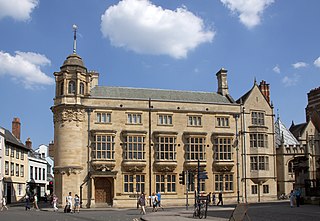
The Indian Institute was an institute within the University of Oxford. It was started by Sir Monier Monier-Williams in 1883 to provide training for the Indian Civil Service of the British Raj. The institute's building is located in central Oxford, England, at the north end of Catte Street, on the corner with Holywell Street, and facing down Broad Street from the east.
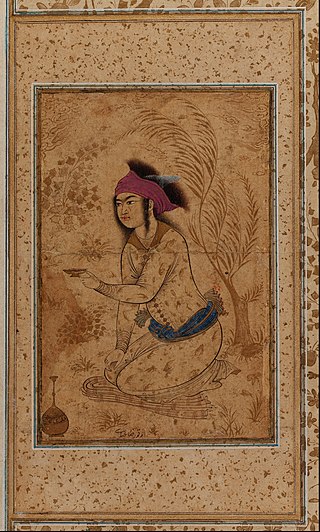
A Muraqqa is an album in book form containing Islamic miniature paintings and specimens of Islamic calligraphy, normally from several different sources, and perhaps other matter. The album was popular among collectors in the Islamic world, and by the later 16th century became the predominant format for miniature painting in the Persian Safavid, Mughal and Ottoman empires, greatly affecting the direction taken by the painting traditions of the Persian miniature, Ottoman miniature and Mughal miniature. The album largely replaced the full-scale illustrated manuscript of classics of Persian poetry, which had been the typical vehicle for the finest miniature painters up to that time. The great cost and delay of commissioning a top-quality example of such a work essentially restricted them to the ruler and a handful of other great figures, who usually had to maintain a whole workshop of calligraphers, artists and other craftsmen, with a librarian to manage the whole process.

Basāwan, or Basāvan, was an Indian miniature painter in the Mughal style. He was known by his contemporaries as a skilled colorist and keen observer of human nature, and for his use of portraiture in the illustrations of Akbarnama, Mughal Emperor, Akbar's official Biography, which is seen as an innovation in Indian art.
Simon Everard Digby was an English oriental scholar, translator, writer and collector who was awarded the Burton Medal of the Royal Asiatic Society and was a former Fellow of Wolfson College, Oxford, the Honorary Librarian of the Royal Asiatic Society and Assistant Keeper in the Department of Eastern Art of the Asmolean Museum in Oxford. He was also the foremost British scholar of pre-Mughal India.
Mary Tregear, FBA was a British museum curator and art historian specializing in Chinese art.
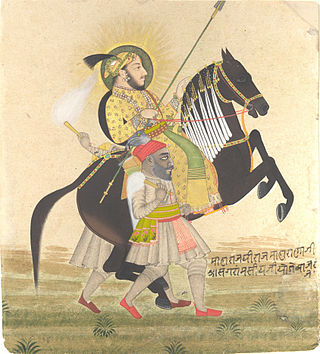
Sangram Singh II was a ruler of Mewar, India. He reigned from 1710 to 1734. He was succeeded by his son Jagat Singh II.
Ruth Barnes is an art historian in the field of South and Southeast Asian textiles. She served as textile curator of the Ashmolean Museum in Oxford before taking up her current position as Curator of Indo-Pacific Art at Yale University. She is a fellow of the Royal Asiatic Society.
Sir Karl Theodore Parker,, occasionally known as KTP, was an English art historian and museum curator. He was Keeper of the Ashmolean Museum, Oxford from 1945 to 1962 and Trustee of the National Gallery from 1962 to 1969.

Gyan Chauper is a dice game derived from chaupar from ancient India, popularly known as Snakes and Ladders. It was from India that it spread to the rest of the world. It was a very popular game that was played not only for entertainment but also as a way to instruct on morality. The central concept of the game is the liberation from bondage of passions. So the players move from the lower levels of consciousness to higher levels of spiritual enlightenment and finally to Moksha.

Naman P. Ahuja is an art historian and curator based in New Delhi. He is Professor of Indian Art and Architecture at Jawaharlal Nehru University, New Delhi where his research and graduate teaching focus on Indian iconography and sculpture, temple architecture and Sultanate-period painting. He is also the Editor of Marg, India’s leading quarterly magazine and journal on the arts, published from Mumbai. His studies on privately owned objects—terracottas, ivories and small finds—have drawn attention to a wide range of ritual cultures and transcultural exchanges at an everyday, quotidian level. He has curated several exhibitions, most notably The Body in Indian Art and Thought, and published books, including The Making of the Modern Indian Artist Craftsman: Devi Prasad.

Deepak Shimkhada is a Nepali American educator, artist, art historian, author and community leader. He currently serves as an adjunct professor at Chaffey College in Rancho Cucamonga, California. He has previously held visiting and adjunct appointments at several universities in the United States, including Scripps College, Claremont Graduate University, California State University, Northridge, University of the West and Claremont School of Theology. His teaching career began in 1980 and although he is fully retired from full-time teaching, he currently teaches Asian art part-time at Chaffey College.
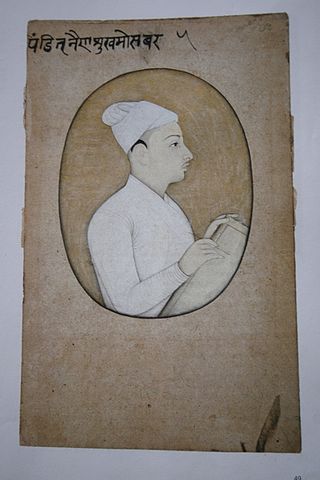
Nainsukh was an Indian painter. He was the younger son of the painter Pandit Seu and, like his older brother Manaku of Guler, was an important practitioner of Pahari painting, and has been called "one of the most original and brilliant of Indian painters".
Chokha was an early 19th-century painter of Rajasthan in India. He was the son of Bakta, also a painter, and produced works for both the courts of Mewar and Devgarh.
Douglas Eric Barrett, FBA (1917–1992) was a specialist in Islamic and Indian art, and was Keeper of Oriental Antiquities at the British Museum.
References
- ↑ Faculty of Oriental Studies (29 April 2015). "Andrew Topsfield - Academic Staff - Faculty of Oriental Studies - University of Oxford". Orinst.ox.ac.uk. Archived from the original on 9 May 2017. Retrieved 3 May 2017.
- ↑ "Andrew Topsfield". Ashmolean Museum of Art and Archaeology – University of Oxford. Retrieved 3 May 2017.
- ↑ "The Khalili Research Centre - Dr Andrew S. Topsfield". Faculty Of Oriental Studies. Archived from the original on 15 June 2017. Retrieved 3 May 2017.